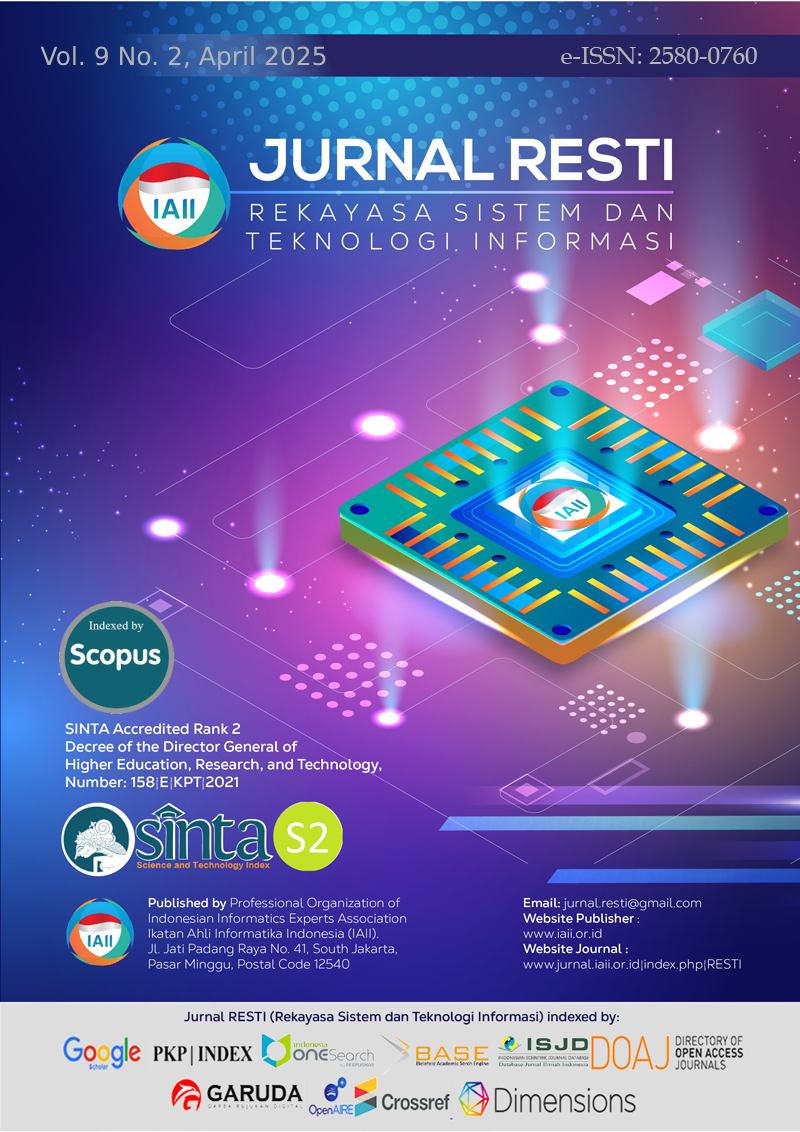Sentiment Analysis of ChatGPT on Indonesian Text using Hybrid CNN and Bi-LSTM
Abstract
This study explores sentiment analysis on Indonesian text using a hybrid deep learning approach that combines Convolutional Neural Networks (CNN) and Bidirectional Long Short-Term Memory (Bi-LSTM). Due to the complex linguistic structure of the Indonesian language, sentiment classification remains challenging, necessitating advanced methods to capture both local patterns and sequential dependencies. The primary objective of this research is to improve sentiment classification accuracy by leveraging a hybrid model that integrates CNN for feature extraction and Bi-LSTM for contextual understanding. The dataset consists of 800 manually labeled samples collected from social media platforms, preprocessed using case folding, stop word removal, and lemmatization. Word embeddings are generated using the Word2Vec CBOW model, and the classification model is trained using a hybrid architecture. The best performance was achieved with 32 Bi-LSTM units, a dropout rate 0.5, and L2 regularization, which was evaluated using Stratified K-Fold cross-validation. Experimental results demonstrate that the hybrid model outperforms conventional deep learning approaches, achieving 95.24% accuracy, 95.09% precision, 95.15% recall, and 95.99% F1 score. These findings highlight the effectiveness of hybrid architectures in sentiment analysis for low-resource languages. Future work may explore larger datasets or transfer learning to enhance generalizability.
Downloads
References
J. Deng and Y. Lin, "The Benefits and Challenges of ChatGPT: An Overview," Frontiers in Computing and Intelligent Systems, vol. 2, no. 2, pp. 81-83, 2022. https://doi.org/10.54097/fcis.v2i2.4465
S. Rice, S. R. Crouse, S. R. Winter and C. Rice, "The advantages and limitations of using ChatGPT to enhance technological research," Technology in Society, vol. 76, 2024. https://doi.org/10.1016/j.techsoc.2023.102426
A. Zein, "Dampak Penggunaan ChatGPT pada Dunia Pendidikan," Jurnal Informatika Utama, vol. 1, no. 2, pp. 19-24, 2023. https://doi.org/10.55903/jitu.v1i2.151
M. Husnaini and L. M. Madhani, "Perspektif Mahasiswa terhadap ChatGPT dalam Menyelesaikan Tugas Kuliah," Journal of Education Research, vol. 5, no. 3, pp. 2655-2664, 2024. https://doi.org/10.37985/jer.v5i3.1047
V. R. Kota and S. D. Munisamy, "High accuracy offering attention mechanisms based deep learning approach using CNN/bi-LSTM for sentiment analysis," International Journal of Intelligent Computing and Cybernetics, vol. 15, no. 1, 2022. https://doi.org/10.1108/IJICC-06-2021-0109
Y. Zhou, Q. Zhang, D. Wang and X. Gu, "Text Sentiment Analysis Based on a New Hybrid Network Model," Computational Intelligence Neuroscience , vol. 6774320, 2022. https://doi.org/10.1155/2022/6774320
M. Abbes, Z. Kechaou and A. M. Alimi, "A Novel Hybrid Model Based on CNN and Bi-LSTM for Arabic Multi-domain Sentiment Analysis," in The 17th International Conference on Complex, Intelligent and Software Intensive Systems (CISIS-2023), Toronto, 2023. https://doi.org/10.1007/978-3-031-35734-3_10
M. Umer, I. Ashraf, A. Mehmood, S. Kumari, S. Ullah and G. S. Choi, "Sentiment analysis of tweets using a unified convolutional neural network-long short-term memory network model," Computational Intelligence, vol. 37, no. 1, pp. 409-434, 2021. https://doi.org/10.1111/coin.12415
P. K. Jain, V. Saravanan and R. Pamula, "A Hybrid CNN-LSTM: A Deep Learning Approach for Consumer Sentiment Analysis Using Qualitative User-Generated Contents," ACM Transactions on Asian and Low-Resource Language Information Processing, vol. 20, no. 5, pp. 1-15, 2021. https://doi.org/10.1145/3457206
D. Atmajaya, A. Febrianti and H. Darwis, "Metode SVM dan Naive Bayes untuk Analisis Sentimen ChatGPT di Twitter," The Indonesian Journal of Computer Science, vol. 12, no. 4, pp. 2173-2181, 2023. https://doi.org/10.33022/ijcs.v12i4.3341
Y. Akbar and T. Sugiharto, "Analisis Sentimen Pengguna Twitter di Indonesia Terhadap ChatGPT Menggunakan Algoritma C4.5 dan Naïve Bayes," Jurnal Sains dan Teknologi, vol. 5, no. 1, pp. 115-122, 2023. https://doi.org/10.55338/saintek.v4i3.1368
V. R. Prasetyo and A. H. Samudra, "Hate speech content detection system on Twitter using K-nearest neighbor method," in International Conference on Informatics, Technology, and Engineering 2021 (InCITE 2021), Surabaya, 2021. https://doi.org/10.1063/5.0080185
R. CNBC Indonesia, "Raja Aplikasi Terbaru di RI, Ternyata Bukan WhatsApp-Instagram," CNBC Indonesia, 26 February 2024. [Online]. Available: https://www.cnbcindonesia.com/tech/20240226153650-37-517653/raja-aplikasi-terbaru-di-ri-ternyata-bukan-whatsapp-instagram. [Accessed 10 January 2025].
M. Leotta, B. García and F. Ricca, "A family of experiments to quantify the benefits of adopting WebDriverManager and Selenium-Jupiter," Information and Software Technology, vol. 178, 2025. https://doi.org/10.1016/j.infsof.2024.107595
M. A. Palomino and F. Aider, "Evaluating the Effectiveness of Text Pre-Processing in Sentiment Analysis," Applied Sciences, vol. 12, no. 17, 2022. https://doi.org/10.3390/app12178765
M. F. Naufal and S. F. Kusuma, "Analisis Sentimen pada Media Sosial Twitter Terhadap Kebijakan Pemberlakuan Pembatasan Kegiatan Masyarakat Berbasis Deep Learning," Jurnal Edukasi dan Penelitian Informatika, vol. 8, no. 1, pp. 44-49, 2022. https://doi.org/10.26418/jp.v8i1.49951
V. R. Prasetyo, G. Erlangga and D. A. Prima, "Analisis Sentimen untuk Identifikasi Bantuan Korban Bencana Alam berdasarkan Data di Twitter Menggunakan Metode K-Means dan Naive Bayes," JurnalTeknologi Informasi dan Ilmu Komputer (JTIIK), vol. 10, no. 5, pp. 1055-1062, 2023. https://doi.org/10.25126/jtiik.20231057077
H. D. Abubakar, M. Umar and M. A. Bakale, "Sentiment Classification: Review of Text Vectorization Methods: Bag of Words, Tf-Idf, Word2vec and Doc2vec," Sule Lamido University Journal of Science & Technology, vol. 4, no. 1, pp. 27-33, 2022. https://doi.org/10.56471/slujst.v4i.266
O. Alharbi, "A Deep Learning Approach Combining CNN and Bi-LSTM with SVM Classifier for Arabic Sentiment Analysis," (IJACSA) International Journal of Advanced Computer Science and Applications, vol. 12, no. 6, pp. 165-172, 2021. https://dx.doi.org/10.14569/IJACSA.2021.0120618
S. Ünalan, O. Günay, I. Akkurt, K. Gunoglu and H. O. Tekin, "A comparative study on breast cancer classification with stratified shuffle split and K-fold cross validation via ensembled machine learning," Journal of Radiation Research and Applied Sciences, vol. 17, no. 4, 2024. https://doi.org/10.1016/j.jrras.2024.101080
Copyright (c) 2025 Jurnal RESTI (Rekayasa Sistem dan Teknologi Informasi)

This work is licensed under a Creative Commons Attribution 4.0 International License.
Copyright in each article belongs to the author
- The author acknowledges that the RESTI Journal (System Engineering and Information Technology) is the first publisher to publish with a license Creative Commons Attribution 4.0 International License.
- Authors can enter writing separately, arrange the non-exclusive distribution of manuscripts that have been published in this journal into other versions (eg sent to the author's institutional repository, publication in a book, etc.), by acknowledging that the manuscript has been published for the first time in the RESTI (Rekayasa Sistem dan Teknologi Informasi) journal ;







